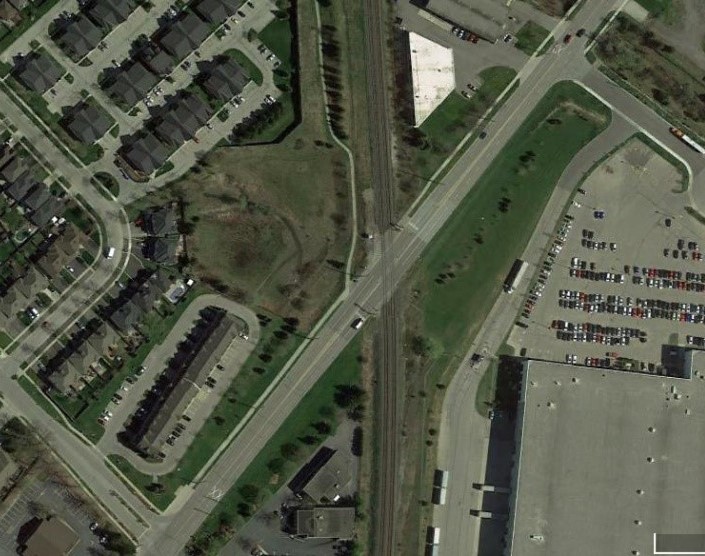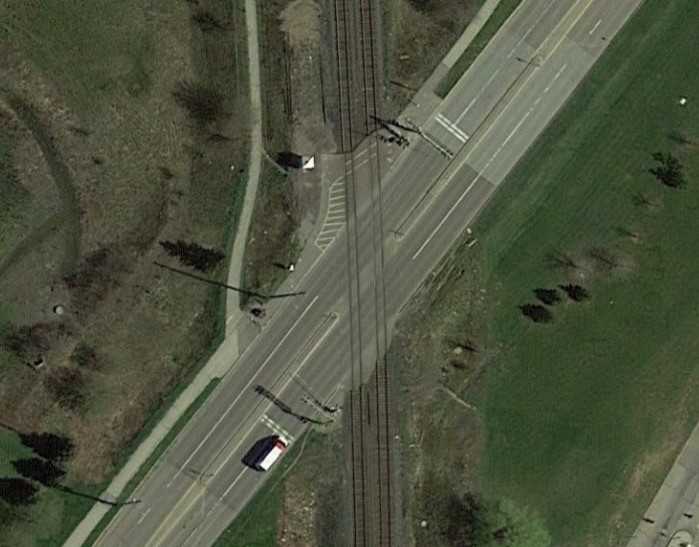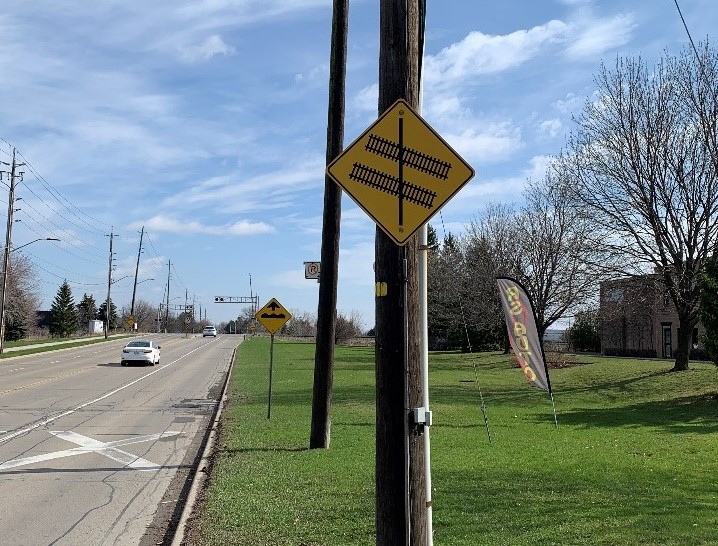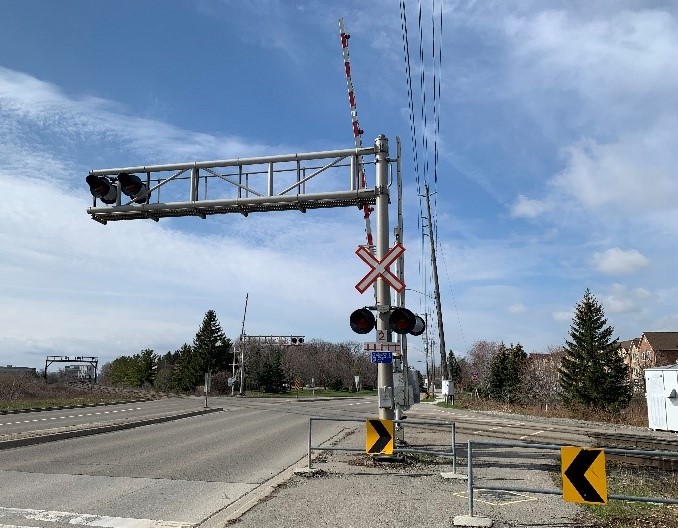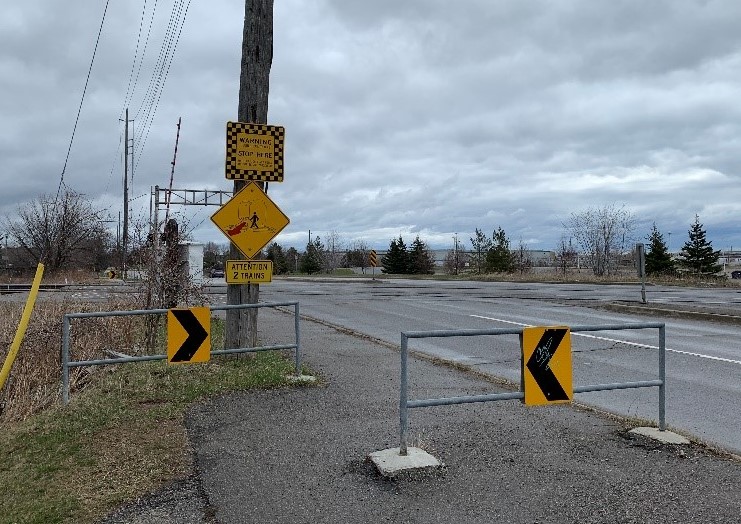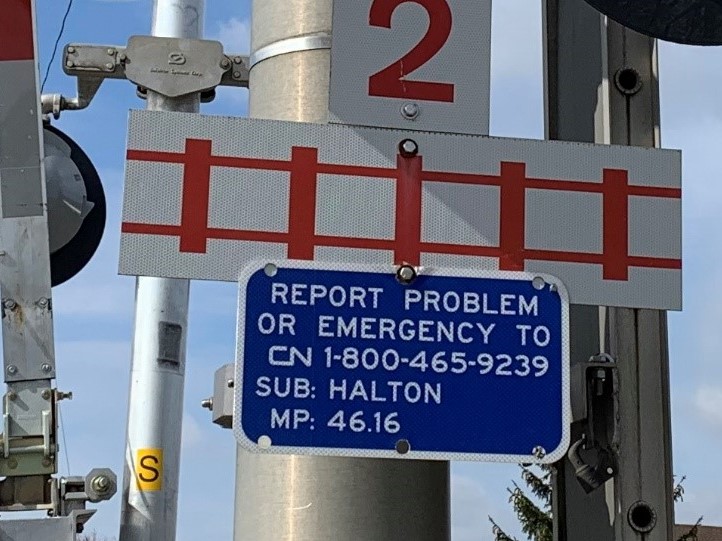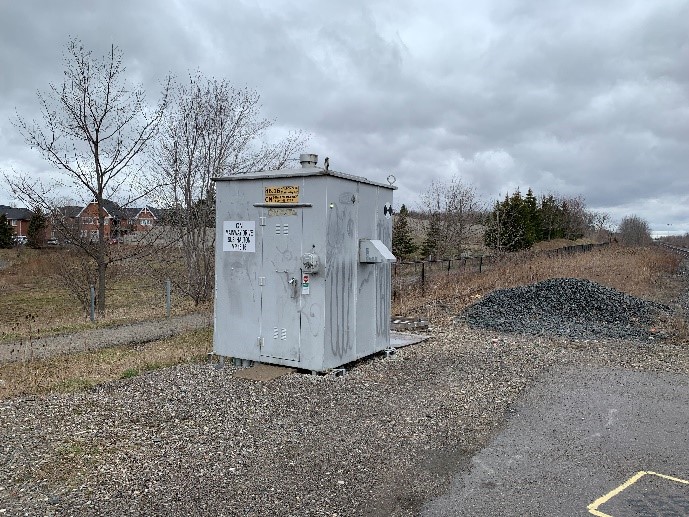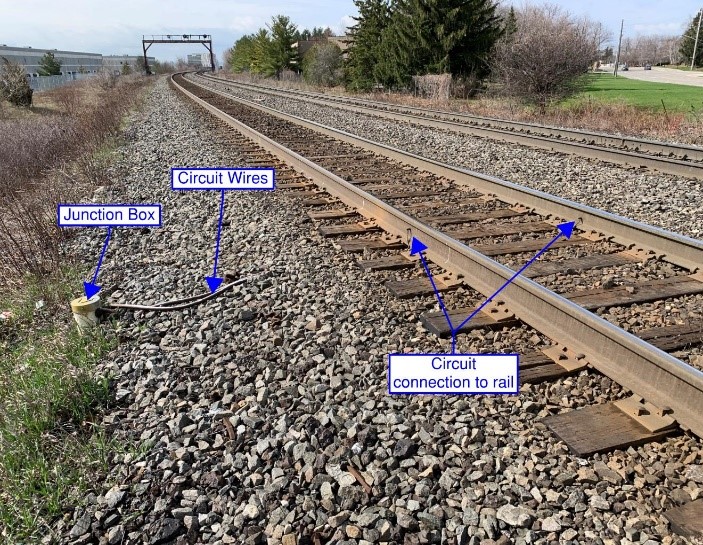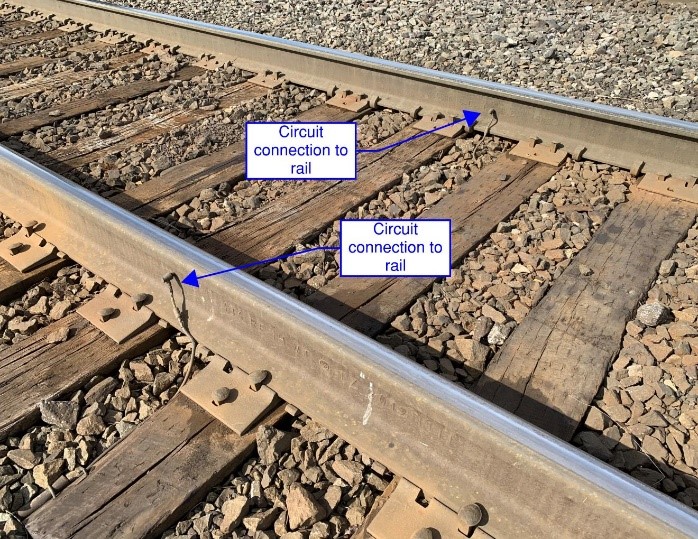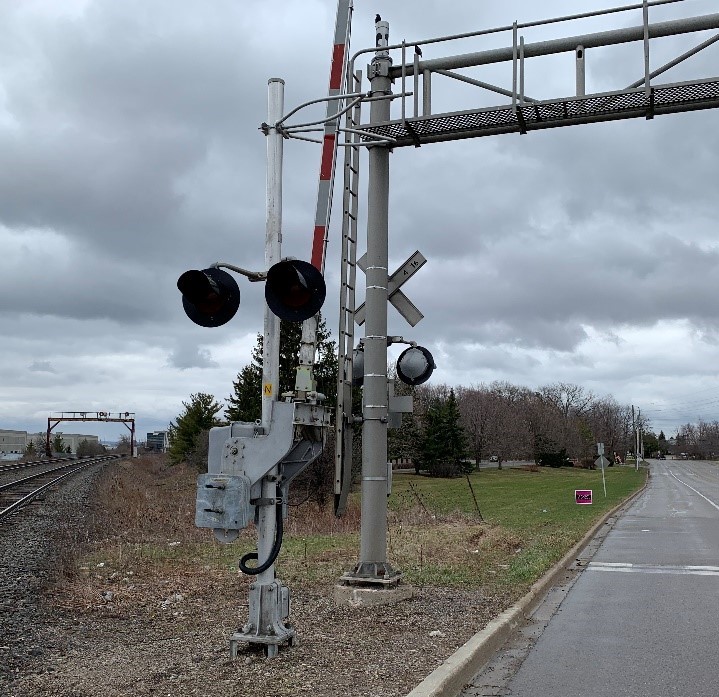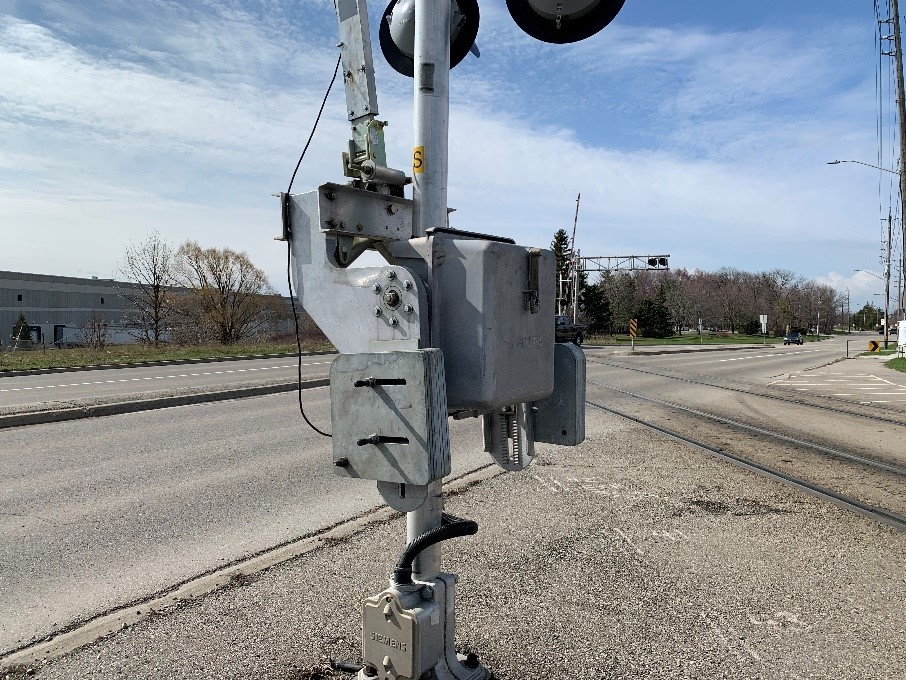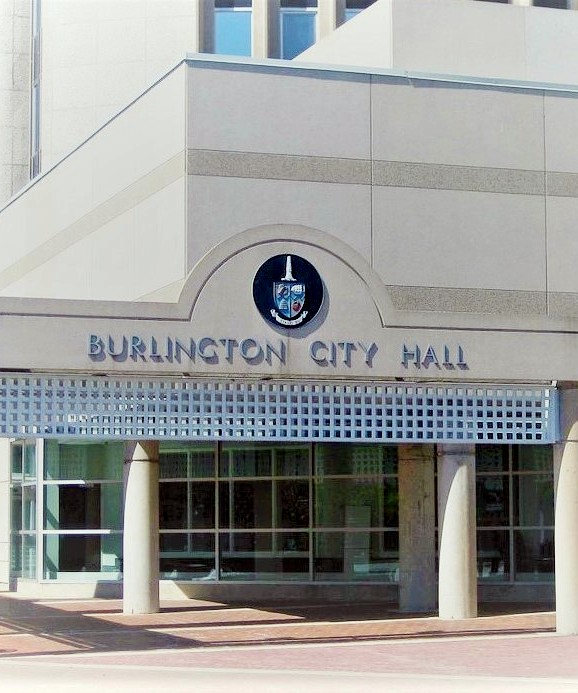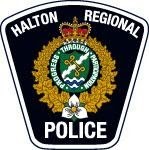Railroad crossings have risks. Trains, cars, and pedestrians shouldn’t mix if it can be avoided. But when they must, the risk and safety of the public needs to be managed. Here’s how it’s done.
There are only two remaining public railroad grade crossings in Burlington, one of which is the Mainway Road crossing north of Highway 403. This is a four-lane road crossing two railroad tracks (see Figure 1).
Freight trains don’t have fixed schedules. Rail companies will tell you to “expect a train from either direction on any track at any time.” Unlike roads, where lanes have a direction, tracks are bi-directional, meaning that on every set of tracks, there could be a train passing in either direction (at any time).
To decide on what safety devices are needed at a railroad crossing, a risk assessment is done using data including volume of train traffic and vehicular traffic; maximum speed on the tracks and road; number of tracks, lanes, and sidewalks; urban or rural environment; sightline visibility; gradient of tracks; angle of approach; proximity of nearby intersections, and more. The equation is clearly a complex one.
The federal government’s rail crossings inventory collected by Transport Canada indicates, for example, that the Mainway Road crossing experiences an average of 7,000 vehicles and 46 trains daily. And the speed limit for vehicles is 60 km/h and for trains is 50 mph. Evidently, rail operators have been around long before the metric system and still measure some things in miles. Based on the assessment, which generates a risk value, signal controls (i.e. gates, bells, lights, signs, medians) are then selected to bring the value down to acceptable levels (see figures 2 and 3).
Pedestrians have their own signs to follow when walking across the Mainway crossing (see figures 4 and 5).
Every crossing has a control cabinet housing a Grade Crossing Predictor (GCP) — a computer equipped with instruments that monitor oncoming trains and the speed at which they approach (see Figure 6).
The cabinet has battery packs that send a low voltage current into one rail, down the tracks a long distance to a fixed relay, which returns the current through the other rail, making a closed circuit. The fixed relay is a connection between the rails that allows the current to jump from the first rail to the other and then return down the rail back towards the cabinet. This is used to detect oncoming trains. Figure 7 shows the wire connection to and from the rail, completing the circuit near the crossing.
When a train passes the relay, the GCP recognizes the train passing the relay and getting closer, increasing the power of the return signal because the wheels and axles act as a moving relay getting closer to the source of the current. When this “moving relay” gets closer, the current no longer needs to travel all the way to the fixed relay, making the travel path of the current shorter and the signal of the return current stronger. This signals to the GCP the distance and travel speed of the approaching train so it can calculate when to trigger the lights and crossing gates. Simple concept.
The crossing gates are made of aluminum. The gate assembly has counterweights balancing the weight of the gate, reducing the stress on the motor. They are required to come down at least 20 seconds prior to the train arriving at the crossing — longer depending on the quantity of tracks, the presence of sidewalks, proximity to highways, etc. This is to ensure that any vehicles or pedestrians on the tracks have time to clear. It is illegal to go around a gate while it is in the down position. It’s actually a very hefty fine! See Figure 8.
In the event of a power failure to the crossing equipment, the gate is designed to lower immediately and prevent vehicles from crossing. This is called a fail-safe system. When the system fails, the crossing shuts down, preventing any interaction between trains and vehicles until the problem is fixed.
Trains have the right-of-way over vehicles (including emergency vehicles) 100% of the time. It’s always fun to see these powerful trains carrying tons of cargo going through town. Admire from a distance and abide by the signs and signals. Afterall, they’re there for you. Be safe!

Fun Facts
The average freight train travelling at 80 km/h can take between one and two kilometres to come to a complete stop.
The longest train in history was over 7.3 km long. It carried iron ore in western Australia from inland mines to Port Hedland in June of 2001.
Have you seen an interesting building or piece of infrastructure in or around Southern Ontario that you’d like Eric Chiasson, your personal engineer, to write about?
Send us your suggestions, comments, or questions to articles@local-news.ca and we’ll see what Eric can find out!
Sources:
McGowan, M.C. Railroad Signaling Explained: Crossings. YouTube. Url: https://www.youtube.com/watch?v=YkzYMi-PY5U (accessed Apr. 17, 2022).
Operation Lifesaver. Devices at the Crossing. Url: https://oli.org/safety-near-trains/track-safety-basics/rail-signs-and-signals/devices-crossing (accessed Apr. 17, 2022).
Transport Canada. Grade Crossings Inventory. Url: https://tc.canada.ca/en/rail-transportation/grade-crossings/grade-crossings-inventory (accessed Apr. 17, 2022).
Wikipedia. Level Crossing Signals. Url: https://en.wikipedia.org/wiki/Level_crossing_signals (accessed Apr. 17, 2022).
For detailed video explanation of how track signals work:
Railroads 101. Signaling Systems. Url: https://www.youtube.com/watch?v=ZztUxEUi290&t=875s (accessed Apr. 17, 2022).
For more information on the author: https://www.linkedin.com/in/eric-chiasson-10601082


